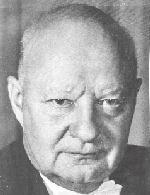Paul Hindemith (1895-1963)
(born Hanau, near Frankfurt, 16 November 1895; died Frankfurt, 28 December
1963).
He studied as a violinist and composer
(with Mendelssohn and Sekles) at the Hoch
Conservatory in Frankfurt (1908-17) and made an early reputation through
his chamber music and
expressionist operas. But
then he turned to neo-classicism
in his "Kammermusik" no.l, the first
of seven such works imitating the
Baroque
concerto
while using an
expanded tonal harmony and
distinctively modern elements, notably jazz. Each uses a different mixed
chamber orchestra, suited to music of linear counterpoint
and, in the fast movements, strongly pulsed rhythm.

During this early period Hindemith lived as a performer: he was leader
of the Frankfurt Opera orchestra (1915-23, with a break for army service),
and he played the viola in the Amar-Hindemith Quartet (1921-9) as well
as in the first performance of Walton's Viola
Concerto (1929). Much of his chamber
music was written in 1917-24, including four of his six
quartets
and numerous
sonatas, and he
was also involved in promoting chamber music through his administrative
work for the Donaueschingen Festival (1923-30). However, he also found
time to compose abundantly in other genres; including lieder
("Das Marienleben", to Rilke poems),
music for newly invented mechanical instruments, music for schoolchildren
and amateurs, and opera ("Cardillac",
a fantasy melodrama in neo-classical forms). In addition, from 1927 he
taught at the Berlin Musikhochschule.
His concern with so many branches of music sprang from a sense of ethical
responsibility that inevitably became more acute with the rise of the Nazis.
With the beginning of the 1930s he moved from chamber ensembles to the
more public domain of the symphony orchestra, and at the same time his
music became harmonically smoother and less intensively
contrapuntal. Then in the opera "Mathis
der Maler" (preceded by a symphony of orchestral excerpts) he
dramatized the dilemma of the artist in society, eventually opposing Brechtian
engagement and insisting on a greater responsibility to art. Nevertheless,
his
music fell under official disapproval, and in 1938 he left for Switzerland,
where "Mathis" had its first performance. He moved
on to the USA and taught at Yale (1940-53), but spent his last decade
back in Switzerland.

His later music is in the style that he had established in the early
1930s and that he had theoretically expounded in his "Craft of Musical
Composition" (1937-9), where he ranks scale degrees
and harmonic intervals in order from most consonant (tonic, octave) to
most dissonant (augmented 4th, tritone), providing a justification for
the primacy of the triad. His large output of the later 1930s and
1940s includes concertos (for
violin, cello, piano, clarinet and horn) and other orchestral works,
as well as sonatas for most of the standard instruments. His search for
an all-encompassing, all-explaining harmony also found expression in his
Kepler opera "Die Harmonie der Welt".
Hindemith always interested himself in the teaching
of music. From 1940 to 1949 he held the post of professor of the
theory of music at Yale University in the United States. Among a
large number of books that he wrote, two stand out as particularly pertinent
to 20th-century theory and composition -- "The Craft of Musical Composition"
(mentioned above), and "A Composer's World: Horizons and Limitations".
They state the individual theory of Hindemith's composing technique as
well as his aesthetic concepts concerning music of the 20th century.

